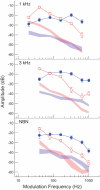Temporal Envelope Coding of the Human Auditory Nerve Inferred from Electrocochleography: Comparison with Envelope Following Responses
- PMID: 35948693
- PMCID: PMC9789235
- DOI: 10.1007/s10162-022-00865-z
Temporal Envelope Coding of the Human Auditory Nerve Inferred from Electrocochleography: Comparison with Envelope Following Responses
Abstract
Neural coding of the slow amplitude fluctuations of sound (i.e., temporal envelope) is thought to be essential for speech understanding; however, such coding by the human auditory nerve is poorly understood. Here, neural coding of the temporal envelope by the human auditory nerve is inferred from measurements of the compound action potential in response to an amplitude modulated carrier (CAPENV) for modulation frequencies ranging from 20 to 1000 Hz. The envelope following response (EFR) was measured simultaneously with CAPENV from active electrodes placed on the high forehead and tympanic membrane, respectively. Results support the hypothesis that phase locking to higher modulation frequencies (> 80 Hz) will be stronger for CAPENV, compared to EFR, consistent with the upper-frequency limits of phase locking for auditory nerve fibers compared to auditory brainstem/cortex neurons. Future work is needed to determine the extent to which (1) CAPENV is a useful tool for studying how temporal processing of the auditory nerve is affected by aging, hearing loss, and noise-induced cochlear synaptopathy and (2) CAPENV reveals the relationship between auditory nerve temporal processing and perception of the temporal envelope.
Keywords: Auditory nerve; Compound action potential; Electrocochleography; Envelope following response; Human; Temporal envelope.
© 2022. The Author(s) under exclusive licence to Association for Research in Otolaryngology.
Figures





Similar articles
-
Envelope following responses predict speech-in-noise performance in normal-hearing listeners.J Neurophysiol. 2021 Apr 1;125(4):1213-1222. doi: 10.1152/jn.00620.2020. Epub 2021 Mar 3. J Neurophysiol. 2021. PMID: 33656936 Free PMC article.
-
Synaptopathy in the Aging Cochlea: Characterizing Early-Neural Deficits in Auditory Temporal Envelope Processing.J Neurosci. 2018 Aug 8;38(32):7108-7119. doi: 10.1523/JNEUROSCI.3240-17.2018. Epub 2018 Jul 5. J Neurosci. 2018. PMID: 29976623 Free PMC article.
-
Effects of sensorineural hearing loss on temporal coding of narrowband and broadband signals in the auditory periphery.Hear Res. 2013 Sep;303:39-47. doi: 10.1016/j.heares.2013.01.014. Epub 2013 Jan 29. Hear Res. 2013. PMID: 23376018 Free PMC article. Review.
-
Magnified Neural Envelope Coding Predicts Deficits in Speech Perception in Noise.J Neurosci. 2017 Aug 9;37(32):7727-7736. doi: 10.1523/JNEUROSCI.2722-16.2017. Epub 2017 Jul 10. J Neurosci. 2017. PMID: 28694336 Free PMC article.
-
Audibility, speech perception and processing of temporal cues in ribbon synaptic disorders due to OTOF mutations.Hear Res. 2015 Dec;330(Pt B):200-12. doi: 10.1016/j.heares.2015.07.007. Epub 2015 Jul 15. Hear Res. 2015. PMID: 26188103 Review.
Cited by
-
Consequences and Mechanisms of Noise-Induced Cochlear Synaptopathy and Hidden Hearing Loss, With Focuses on Signal Perception in Noise and Temporal Processing.Adv Sci (Weinh). 2025 Aug;12(29):e2409322. doi: 10.1002/advs.202409322. Epub 2025 Apr 7. Adv Sci (Weinh). 2025. PMID: 40192209 Free PMC article. Review.
-
Computational modeling of the human compound action potential.J Acoust Soc Am. 2023 Apr 1;153(4):2376. doi: 10.1121/10.0017863. J Acoust Soc Am. 2023. PMID: 37092943 Free PMC article.
-
Middle ear muscle and medial olivocochlear activity inferred from individual human ears via cochlear potentials.J Acoust Soc Am. 2023 Mar;153(3):1723. doi: 10.1121/10.0017604. J Acoust Soc Am. 2023. PMID: 37002081 Free PMC article.
-
Effects of contralateral noise on envelope-following responses, auditory-nerve compound action potentials, and otoacoustic emissions measured simultaneously.J Acoust Soc Am. 2024 Mar 1;155(3):1813-1824. doi: 10.1121/10.0025137. J Acoust Soc Am. 2024. PMID: 38445988 Free PMC article.
-
Evidence for the Auditory Nerve Generating Envelope Following Responses When Measured from Eardrum Electrodes.J Assoc Res Otolaryngol. 2025 Apr;26(2):147-162. doi: 10.1007/s10162-025-00979-0. Epub 2025 Mar 6. J Assoc Res Otolaryngol. 2025. PMID: 40048123
References
Publication types
MeSH terms
Grants and funding
LinkOut - more resources
Full Text Sources
Miscellaneous

